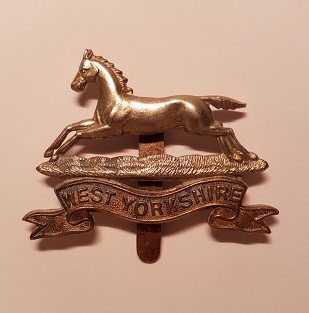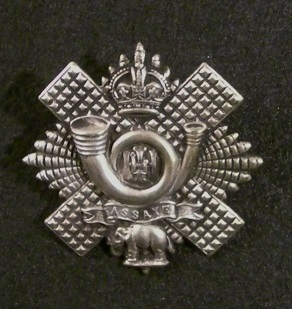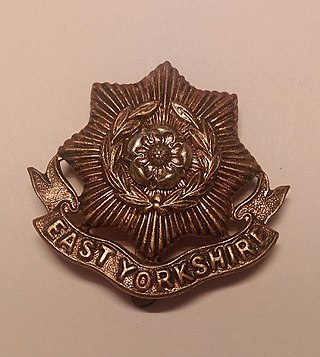
The 5th Infantry Division was a regular army infantry division of the British Army. It was established by Arthur Wellesley, 1st Duke of Wellington for service in the Peninsular War, as part of the Anglo-Portuguese Army, and was active for most of the period since, including the First World War and the Second World War and was disbanded soon after. The division was reformed in 1995 as an administrative division covering Wales and the English regions of West Midlands, East Midlands and East. Its headquarters were in Shrewsbury. It was disbanded on 1 April 2012.

The Lancashire Fusiliers was a line infantry regiment of the British Army that saw distinguished service through many years and wars, including the Second Boer War, the First and Second World Wars, and had many different titles throughout its 280 years of existence. In 1968 the regiment was amalgamated with the other regiments of the Fusilier Brigade – the Royal Northumberland Fusiliers, Royal Warwickshire Fusiliers and the Royal Fusiliers – to form the current Royal Regiment of Fusiliers.

The 31st Division was an infantry division of the British Army. It was raised in the Great War by volunteers from Kitchener's Army and formed in April 1915 as part of the K4 Army Group and taken over by the War Office on 10 August 1915. Comprising mainly infantry battalions from Yorkshire and Lancashire, the division was sent to Egypt in December 1915 before moving to France in March 1916 and spent the remainder of the First World War in action on the Western Front. The 31st Division was the quintessential New Army division, being made up entirely of Pals battalions.

The 32nd Division was an infantry division of the British Army that was raised in 1914, during the First World War. The division was raised from volunteers for Lord Kitchener's New Armies, made up of infantry 'Pals battalions' and artillery brigades raised by public subscription or private patronage. The division was taken over by the War Office in September 1915. It served in France and Belgium in the trenches of the Western Front for the duration of the war. It saw action at the Battle of the Somme, the Pursuit to the Hindenburg Line, the Defence of Nieuport, the German spring offensive, and the Allied Hundred Days Offensive beginning at the Battle of Amiens. After the Armistice it marched into Germany as part of the Army of Occupation.

The West Yorkshire Regiment (Prince of Wales's Own) (14th Foot) was an infantry regiment of the British Army. In 1958 it amalgamated with the East Yorkshire Regiment (15th Foot) to form the Prince of Wales's Own Regiment of Yorkshire which was, on 6 June 2006, amalgamated with the Green Howards and the Duke of Wellington's Regiment (West Riding) to form the Yorkshire Regiment (14th/15th, 19th and 33rd/76th Foot).

The Highland Light Infantry (HLI) was a light infantry regiment of the British Army formed in 1881. It took part in the First and Second World Wars, until it was amalgamated with the Royal Scots Fusiliers in 1959 to form the Royal Highland Fusiliers which later merged with the Royal Scots Borderers, the Black Watch, the Highlanders and the Argyll and Sutherland Highlanders to form the Royal Regiment of Scotland, becoming the 2nd Battalion of the new regiment.

The Royal Warwickshire Regiment, previously titled the 6th Regiment of Foot, was a line infantry regiment of the British Army in continuous existence for 283 years. The regiment saw service in many conflicts and wars, including the Second Boer War and both the First and Second World Wars. On 1 May 1963, the regiment was re-titled, for the final time, as the Royal Warwickshire Fusiliers and became part of the Fusilier Brigade.
The 14th Infantry Brigade was a British Army formation during the Second Boer War, World War I, when it served on the Western Front, and World War II, when it fought in Crete and Tobruk, and then as Chindits in Burma.
The 13th Infantry Brigade was a regular infantry brigade of the British Army that saw active service during both the First and the Second World Wars.

The Barnsley Pals were two 'Pals battalions' formed as part of 'Kitchener's Army' during World War I. Raised by local initiative in the town of Barnsley in the West Riding of Yorkshire and recruited largely from coalminers, they became the 13th and 14th (Service) Battalions of the local York and Lancaster Regiment. After almost two years of training, the battalions suffered heavy casualties in a disastrous attack on the village of Serre on the first day of the Battle of the Somme. They continued to serve on the Western Front, including the Battle of Arras (1917). Combined into a single battalion in early in 1918, the Barnsley Pals were reduced to a remnant during the German spring offensive, but the battalion was rebuilt to participate in the final victorious Hundred Days Offensive.

The Sherwood Foresters was a line infantry regiment of the British Army in existence for just under 90 years, from 1881 to 1970. In 1970, the regiment was amalgamated with the Worcestershire Regiment to form the Worcestershire and Sherwood Foresters Regiment, which in 2007 was amalgamated with the Cheshire Regiment and the Staffordshire Regiment to form the present Mercian Regiment. The lineage of the Sherwood Foresters is now continued by The Mercian Regiment.

Entrenching battalions were temporary units formed in the armies of the British Empire during the First World War. Entrenching Battalions were trained as infantry, but were primarily utilized for manual labour duties such as trench repair, wire laying, road making and assisting tunnellers, pioneers, engineers and signals. The Battalions were also used as pools of men from which drafts of replacements could be drawn by conventional infantry battalions.
The 92nd Brigade was an infantry formation of the British Army during World War I. It was raised as part of 'Kitchener's Army' and was assigned to the 31st Division. After the original formation was converted into a reserve brigade, the number was transferred to a brigade composed volunteer battalions raised in the city of Kingston upon Hull for 'Kitchener's Army'. It first served in Egypt defending the Suez Canal between January and March 1916. It then left for the Western Front where it was at Serre on the first day of the Battle of the Somme in 1916, though its battalions escaped the worst of the disaster. It continued to serve on the Western Front for the rest of the war, including hard fighting at Oppy Wood, against the German spring offensive and in the final Hundred Days Offensive.
The 93rd Brigade was an infantry formation of the British Army during World War I. It was raised as part of 'Kitchener's Army' and was assigned to the 31st Division. After the original formation was converted into a reserve brigade, the number was transferred to a brigade of 'Pals battalions' from Northern England. The brigade was sent to Egypt at the end of 1915 but was recalled to France shortly afterwards and then served on the Western Front for the rest of the war. The brigade was shattered on the First day on the Somme, but later saw action at Arras, in the German spring offensive of 1918, and the final Hundred Days Offensive.
The 95th Brigade was an infantry brigade formation of the British Army, created during World War I. It was raised from men volunteering for Lord Kitchener's New Armies and assigned to the 32nd Division. The brigade, initially composed of three service battalions of the Royal Warwickshire Regiment and one of the Gloucestershire Regiment, was sent to the Western Front in November 1915, where it was to serve for most of the war, and later briefly on the Italian Front in late 1917 before returning to the Western Front in April 1918. In December 1915, the brigade was transferred to the 5th Division, a Regular Army formation, and all three battalions of the Royal Warwickshire Regiment were exchanged for three Regular Army battalions, and was to remain with this composition for the rest of the war.
221st Mixed Brigade was a Scottish Home Service formation of the British Army that served under various titles throughout World War I.

The Hull Pals were a brigade of four battalions of the East Yorkshire Regiment raised as part of Kitchener's Army in 1914. They served in 31st Division at Serre on the first day of the Battle of the Somme in 1916, though they escaped the worst of the disaster. However, they suffered heavy casualties in the same area later in the year, and again at Oppy Wood in early 1917. They continued to serve on the Western Front for the rest of the war, including hard fighting against the German spring offensive and in the final Hundred Days Offensive.

The 12th (Service) Battalion of the Gloucestershire Regiment was a 'Pals battalion' of 'Kitchener's Army' raised immediately after the outbreak of World War I through the initiative of the City of Bristol. It saw action at the Somme, Arras and Ypres, before moving to the Italian Front. It returned to the Western Front to fight in the German spring offensive and the victorious Allied Hundred Days Offensive.














